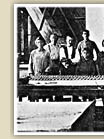
Indeed, whereas the population between 1896 and 1907 increased by 188,146
people, between 1907 and 1920 it increased by 2,384,937 people, corresponding to
the inhabitants of Epirus, Macedonia and Thrace. Demographers assess
that the average natural population increase in the specific period,
that is the increase resulting from the differential between births and
deaths and not the massive annexation of peoples to the state, did not exceed 13.2 per cent. In the same period refugees thronged to Greece from various
areas, either fleeing war or under the control of
enemy forces (Bulgaria, Turkey).
Table 1: Population of Greece 1896-1920
| Year of census | Population | Increase between
census (%) |
| 1896 | 2.443.806 | -- |
| 1907 | 2.631.952 | 8.1 |
| 1920 | 5.016.889 | 90.6 |
Source: D. Tsaousis, I morfologia tis neoellinikis koinonias,
Athens, 1971, p. 177.
As concerns the economically active population, the age groups between
15 and 64 years old who actively took part in the production process, in terms of percentage
of the total population, a relatively small increase is observed (from
57 per cent in 1900 to 62 per cent in 1928) caused by constant wars, the casualties
of which concern productive ages. Among these the largest part
ranges between 65 per cent and 70 per cent, and were occasionally occupied in the primary
sector (agriculture), then follows the tertiary sector (services,
trade, public administration) with participation between 17 per cent up to 20 per cent and the
secondary sector (manufacturing and industry) with percentages between 10 per cent and 13 per cent of the active population.
In the same period the population of urban centres increased,
where most economic activities took place. Fluctuations in distributions
per sector of production are shown in the following table:
Table 2: working population of Greece 1879-1920 (Distribution %)
| . | 1879 | 1907 | 1920 |
| Primary sector | 69.9 | 66.3 | 70,0 |
| Secondary sector | 11.8 | 12.8 | 13.1 |
| Tertiary sector | 18.3 | 20.9 | 17 |
Source: St. Tsotsoros, I singrotisi tou viomihanikou kefalaiou
stin Ellada (1898-1939), volume 1 I argosyrti ekviomihanisi,
Athens, National Bank Cultural Foundation (MIET), 1993, p. 86.
|
 |
